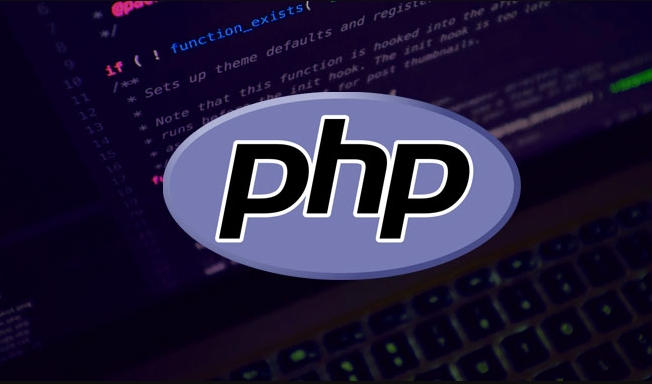A detailed guide to setting up a PHP environment using WAMP
Jun 27, 2025 am 01:03 AMSetting up a PHP environment with WAMP is simple and efficient. 1. Download the correct version of WAMP (32-bit or 64-bit) from the official site and install it, accepting defaults and allowing firewall access. 2. Launch WAMP, wait for the icon to turn green indicating all services are running, and use the system tray menu to manage Apache, MySQL, and project files. 3. Place PHP projects in the default www directory (C:\wamp64\www\), accessing them via http://localhost/projectname. 4. Configure PHP by editing php.ini through the WAMP menu, adjusting settings like upload size or enabling extensions, and manage MySQL databases using phpMyAdmin. 5. Troubleshoot common issues like blocked ports, incorrect php.ini files, or MySQL crashes by checking conflicting apps, editing the correct configuration files, or reinitializing data. Always back up before reinstalling or upgrading.

Setting up a PHP environment doesn’t have to be complicated, and using WAMP (Windows, Apache, MySQL, PHP) makes it much easier. Whether you're just starting out or need a local test server for development, WAMP gives you everything you need in one package. Here's how to do it right without getting stuck.

Installing WAMP Server
The first step is to grab the right version of WAMP from its official site. Make sure you choose the correct architecture — 32-bit or 64-bit — based on your Windows system. Once downloaded, run the installer like any other program.

- Run the installer as administrator
- Accept default settings unless you have specific needs
- Let it install all components (Apache, MySQL, PHP included)
During installation, you might get a popup asking which browser to use — just pick your default one. Also, if you see a firewall prompt, allow access so Apache can work properly.
Starting the Server and Checking the Status
After installation, launch WAMP from your desktop or Start menu. You’ll see an icon appear in the system tray. Wait until it turns green — that means all services are running correctly.

Clicking the icon gives you access to controls:
- Restart all services
- Switch Apache/MySQL versions (if multiple installed)
- Access local projects and configuration files
If the icon stays orange or red, something’s blocking Apache or MySQL. A common reason is another program using port 80 — often Skype or IIS. Close those apps and restart WAMP.
Putting Your Files in the Right Place
WAMP serves files from the www directory by default. This is where you should place your PHP projects. The path is usually:
C:\wamp64\www\
Inside this folder, create a new folder for each project. For example:
C:\wamp64\www\myproject\index.php- Then visit
http://localhost/myprojectin your browser
You can also set up virtual hosts later if you want cleaner URLs like http://myproject.local, but for basic use, sticking with localhost paths works fine.
Configuring PHP and MySQL Basics
WAMP lets you edit PHP and MySQL settings directly from the system tray menu.
For PHP:
- Go to PHP > php.ini to tweak settings like upload size (
upload_max_filesize) or error reporting - Common changes: enabling extensions like
php_curl,php_mbstring, etc.
For MySQL:
- Use tools like phpMyAdmin (available through the WAMP menu) to manage databases
- Create databases and users via the interface instead of command line
If you change settings and they don’t take effect, always remember to restart all services from the WAMP menu.
Troubleshooting Common Issues
Sometimes things don’t go smoothly. Here are a few common problems and what to check:
- Server won’t start: Check if ports 80 and 3306 are free
-
PHP errors not showing: Make sure
display_errors = Onin php.ini - Changes not saving: Did you edit the right php.ini file? Use WAMP’s menu to open it directly
- MySQL crashes on startup: Could be due to leftover data from a previous failed install — try reinitializing
Also, don’t forget to back up your databases and code before reinstalling or upgrading WAMP versions.
That’s basically it. WAMP handles most of the setup for you, and once you know where the files go and how to tweak the settings, it becomes a solid base for PHP development. It’s simple enough for beginners but flexible enough for more advanced uses.
The above is the detailed content of A detailed guide to setting up a PHP environment using WAMP. For more information, please follow other related articles on the PHP Chinese website!

Hot AI Tools

Undress AI Tool
Undress images for free

Undresser.AI Undress
AI-powered app for creating realistic nude photos

AI Clothes Remover
Online AI tool for removing clothes from photos.

Clothoff.io
AI clothes remover

Video Face Swap
Swap faces in any video effortlessly with our completely free AI face swap tool!

Hot Article

Hot Tools

Notepad++7.3.1
Easy-to-use and free code editor

SublimeText3 Chinese version
Chinese version, very easy to use

Zend Studio 13.0.1
Powerful PHP integrated development environment

Dreamweaver CS6
Visual web development tools

SublimeText3 Mac version
God-level code editing software (SublimeText3)

Hot Topics
 What are some best practices for versioning a PHP-based API?
Jun 14, 2025 am 12:27 AM
What are some best practices for versioning a PHP-based API?
Jun 14, 2025 am 12:27 AM
ToversionaPHP-basedAPIeffectively,useURL-basedversioningforclarityandeaseofrouting,separateversionedcodetoavoidconflicts,deprecateoldversionswithclearcommunication,andconsidercustomheadersonlywhennecessary.StartbyplacingtheversionintheURL(e.g.,/api/v
 How do I implement authentication and authorization in PHP?
Jun 20, 2025 am 01:03 AM
How do I implement authentication and authorization in PHP?
Jun 20, 2025 am 01:03 AM
TosecurelyhandleauthenticationandauthorizationinPHP,followthesesteps:1.Alwayshashpasswordswithpassword_hash()andverifyusingpassword_verify(),usepreparedstatementstopreventSQLinjection,andstoreuserdatain$_SESSIONafterlogin.2.Implementrole-basedaccessc
 What are the differences between procedural and object-oriented programming paradigms in PHP?
Jun 14, 2025 am 12:25 AM
What are the differences between procedural and object-oriented programming paradigms in PHP?
Jun 14, 2025 am 12:25 AM
Proceduralandobject-orientedprogramming(OOP)inPHPdiffersignificantlyinstructure,reusability,anddatahandling.1.Proceduralprogrammingusesfunctionsorganizedsequentially,suitableforsmallscripts.2.OOPorganizescodeintoclassesandobjects,modelingreal-worlden
 What are weak references (WeakMap) in PHP, and when might they be useful?
Jun 14, 2025 am 12:25 AM
What are weak references (WeakMap) in PHP, and when might they be useful?
Jun 14, 2025 am 12:25 AM
PHPdoesnothaveabuilt-inWeakMapbutoffersWeakReferenceforsimilarfunctionality.1.WeakReferenceallowsholdingreferenceswithoutpreventinggarbagecollection.2.Itisusefulforcaching,eventlisteners,andmetadatawithoutaffectingobjectlifecycles.3.YoucansimulateaWe
 How can you handle file uploads securely in PHP?
Jun 19, 2025 am 01:05 AM
How can you handle file uploads securely in PHP?
Jun 19, 2025 am 01:05 AM
To safely handle file uploads in PHP, the core is to verify file types, rename files, and restrict permissions. 1. Use finfo_file() to check the real MIME type, and only specific types such as image/jpeg are allowed; 2. Use uniqid() to generate random file names and store them in non-Web root directory; 3. Limit file size through php.ini and HTML forms, and set directory permissions to 0755; 4. Use ClamAV to scan malware to enhance security. These steps effectively prevent security vulnerabilities and ensure that the file upload process is safe and reliable.
 How can you interact with NoSQL databases (e.g., MongoDB, Redis) from PHP?
Jun 19, 2025 am 01:07 AM
How can you interact with NoSQL databases (e.g., MongoDB, Redis) from PHP?
Jun 19, 2025 am 01:07 AM
Yes, PHP can interact with NoSQL databases like MongoDB and Redis through specific extensions or libraries. First, use the MongoDBPHP driver (installed through PECL or Composer) to create client instances and operate databases and collections, supporting insertion, query, aggregation and other operations; second, use the Predis library or phpredis extension to connect to Redis, perform key-value settings and acquisitions, and recommend phpredis for high-performance scenarios, while Predis is convenient for rapid deployment; both are suitable for production environments and are well-documented.
 What are the differences between == (loose comparison) and === (strict comparison) in PHP?
Jun 19, 2025 am 01:07 AM
What are the differences between == (loose comparison) and === (strict comparison) in PHP?
Jun 19, 2025 am 01:07 AM
In PHP, the main difference between == and == is the strictness of type checking. ==Type conversion will be performed before comparison, for example, 5=="5" returns true, and ===Request that the value and type are the same before true will be returned, for example, 5==="5" returns false. In usage scenarios, === is more secure and should be used first, and == is only used when type conversion is required.
 How do I perform arithmetic operations in PHP ( , -, *, /, %)?
Jun 19, 2025 pm 05:13 PM
How do I perform arithmetic operations in PHP ( , -, *, /, %)?
Jun 19, 2025 pm 05:13 PM
The methods of using basic mathematical operations in PHP are as follows: 1. Addition signs support integers and floating-point numbers, and can also be used for variables. String numbers will be automatically converted but not recommended to dependencies; 2. Subtraction signs use - signs, variables are the same, and type conversion is also applicable; 3. Multiplication signs use * signs, which are suitable for numbers and similar strings; 4. Division uses / signs, which need to avoid dividing by zero, and note that the result may be floating-point numbers; 5. Taking the modulus signs can be used to judge odd and even numbers, and when processing negative numbers, the remainder signs are consistent with the dividend. The key to using these operators correctly is to ensure that the data types are clear and the boundary situation is handled well.






